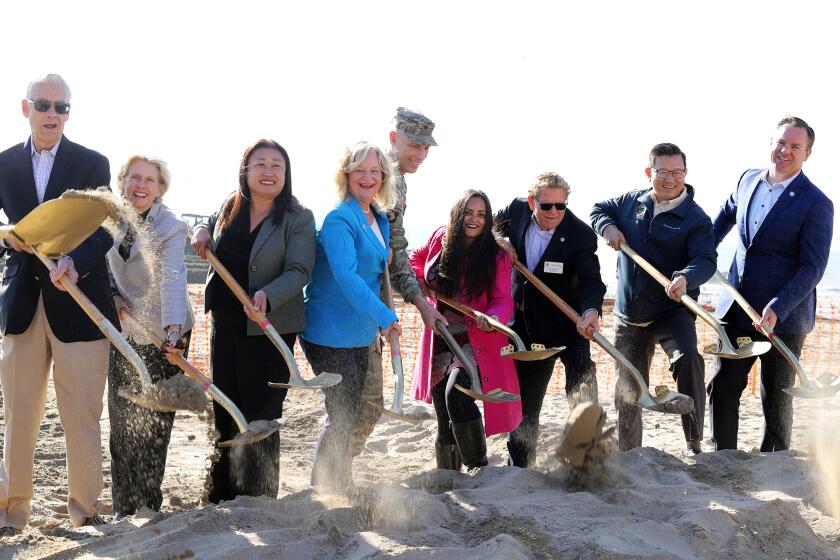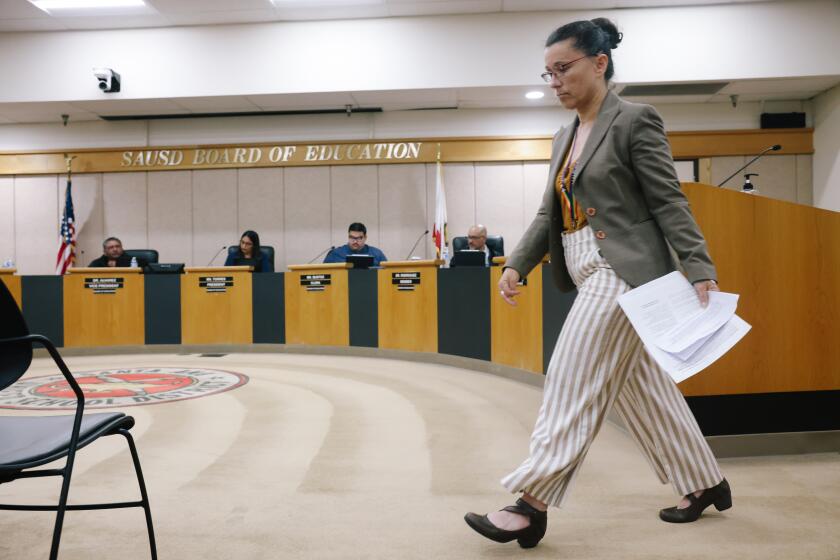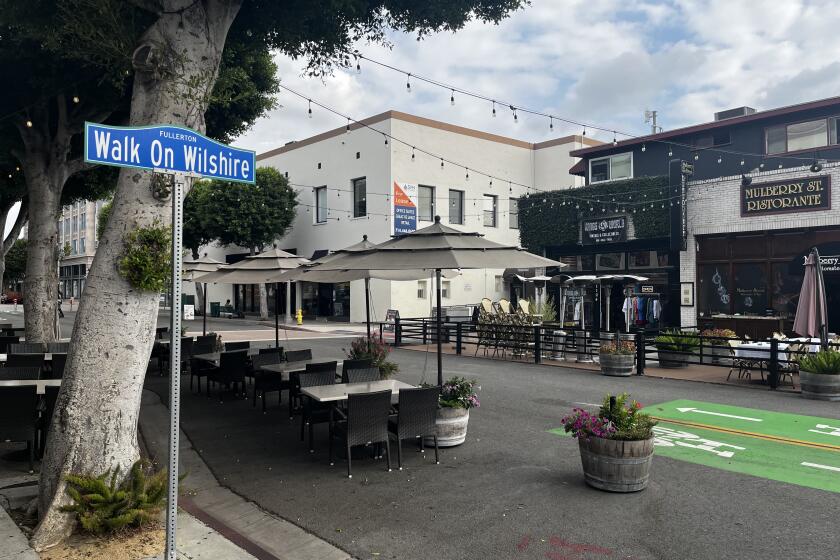Good sand is hard to find in efforts to rebuild San Clemente’s eroding beaches
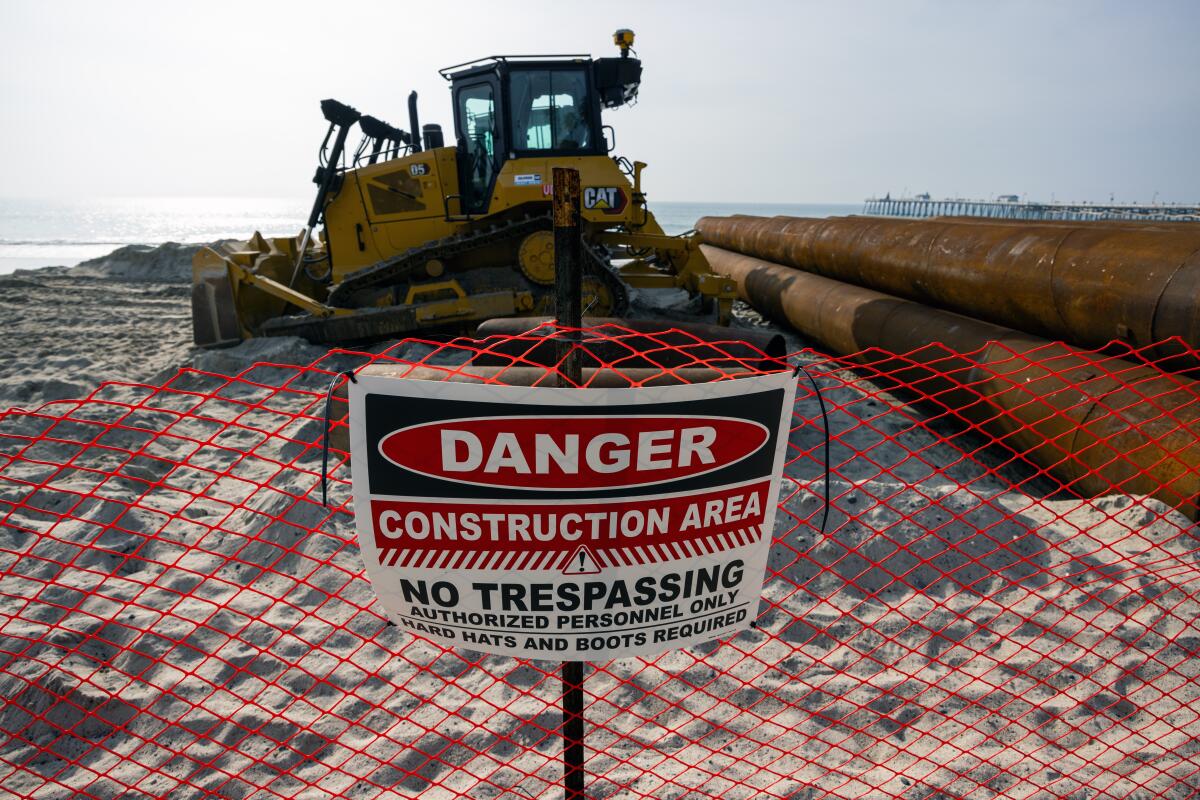
- Share via
A brisk January morning in San Clemente might have seemed like another postcard portrait from the self-styled “Spanish village by the sea.”
Surfers bobbed in the ocean while waiting to catch the next wave. Joggers glistened with sweat along the city’s popular beach trail. Couples strolled hand in hand down a lengthy, wooden pier.
But a sight south of the pier hinted at trouble in paradise.
Two large dozers backed into crashing waves, shoveled pipe-pumped sand and dumped it onto the beach.
The scene offered a brief glimpse into the first phase of a long-awaited sand replenishment project, a $14-million effort to repair a coastline crumbled by urban development, drought and climate change, which had gotten off to a rocky start.
The dredge site off the coast of Oceanside, which was selected after decades of study and sampling, plagued the project with gravely sediment that damaged equipment.
A series of storms and king tides added to the challenges.
On Jan. 15, the U.S. Army Corps of Engineers, which is overseeing the project, agreed to an initial 70-day delay to address the poor quality of sand. In the meantime, the contractor working in San Clemente moved on to a federally supported sand replenishment project at Solana Beach in San Diego County.
San Clemente officials had hoped that the half-mile of remediated beach would be 50 feet wider in February thanks to 251,000 cubic yards of pumped sand.
Rep. Mike Levin and San Clemente Mayor Victor Cabral issued a joint statement in January expressing disappointment with the delay.
“While this is a setback, we will continue to fight for the completion of this project in the coming months,” they said. “Longer term delay is unacceptable.”
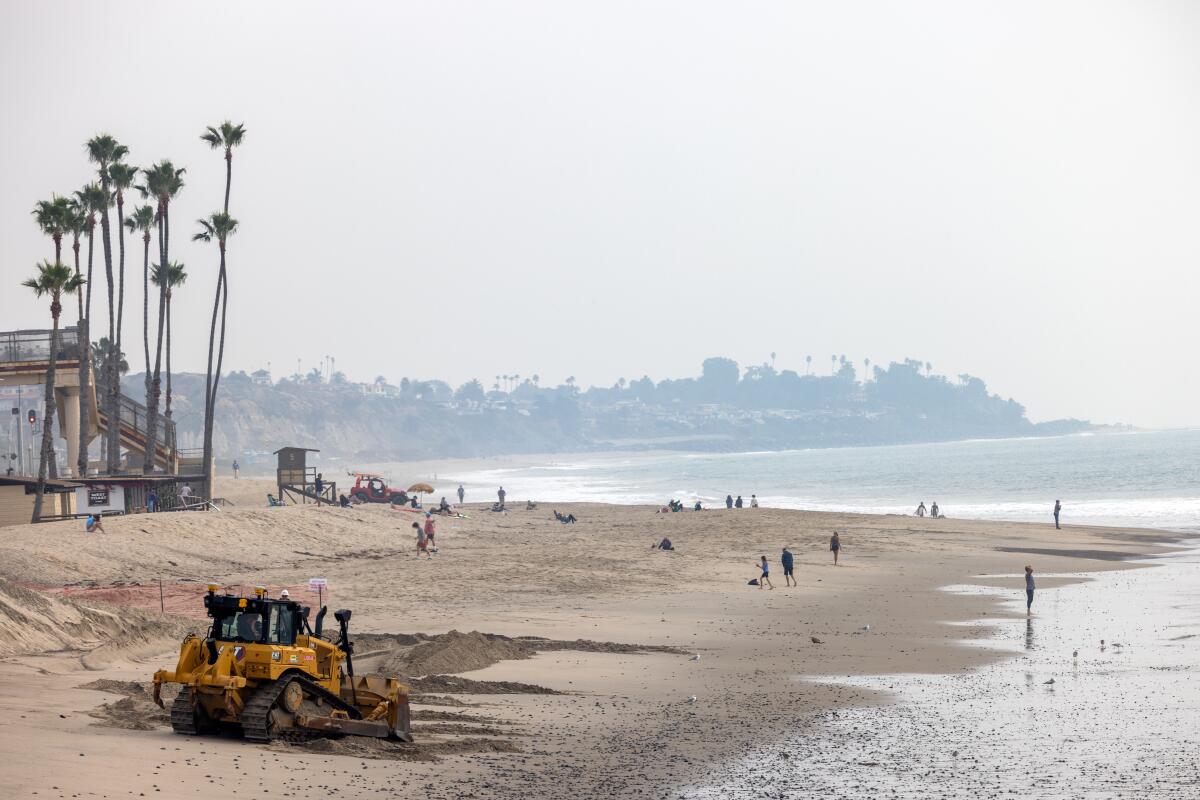
The mood was more triumphant on Dec. 18 when local and federal officials gathered in San Clemente’s “Pier Bowl,” a topographical curve dotted with boutique hotels and restaurants, to boost sand replenishment, a project that finally began after being on the table for nearly 25 years.
Before a scheduled press conference, Levin, a Democrat, sat at a park bench next to the historic Beachcomber Inn overlooking construction. The congressman secured $9.3 million in federal funding to spearhead the project, which is expected to pump 2 million cubic yards of sand over 50 years.
“You can’t have a beach town without a beach,” Levin said. “Candidly, we have to do more. There are other areas of our district that need sand as well. But getting these projects underway is really important.”
San Clemente was the first of three federally supported efforts to remediate sand-starved beaches in the 49th Congressional District he represents, which spans the coastlines of southern Orange County and northern San Diego County.
Levin secured $30.5 million for the Solana Beach and Encinitas projects.
He cited 140,000 jobs related to coastal tourism in his district in underscoring the necessity while also touting beach nourishment as another way to protect the vital Lossan (short for Los Angeles-San Diego-San Luis Obispo) corridor, a busy passenger and freight line that connects San Diego to Los Angeles through scenic shore-side routes increasingly imperiled by erosion.
“We do know that we see consistent erosion,” he said. “That’s been the case for a number of years, and I have no reason to believe it’s going to change anytime soon.”
Stage 13 of the project will replenish sand in Seal Beach, Huntington Beach and Newport Beach to provide a protective natural barrier.
Pumping sand onto beaches isn’t a novel concept. The practice dates back at least a century with an effort to widen the sands along Coney Island in New York City.
On the West Coast, an ongoing beach nourishment project in Seal Beach and Huntington Beach dates back to the 1960s. In other similar projects, deposited sand helped create a modern mirage of California’s vast beaches.
“There’s a misconception that still seems to be prevalent that beaches were all very wide and that somehow development made them narrower,” said Ron Flick, a research associate at the Scripps Institution of Oceanography. “The widest beaches in California are essentially manmade.”
The oceanographer points to Santa Monica Bay as a prime example.
But with climate change poised to bring dramatic sea level rise by mid-century, officials are now turning to sand replenishment out of a greater sense of urgency to build coastal resiliency.
Flick said that San Clemente is a preview of tough, costly decisions that will have to be made up and down California’s coastlines.
Not all are convinced that sand replenishment is the best way to combat beach erosion.
Stefanie Sekich, senior manager for the Surfrider Foundation’s coasts and climate initiative, remains doubtful about its long-term prospects.
“There’s no way to make sand stay, unless you have a terrestrial source refeeding that beach,” Sekich said. “We don’t have that in this area because we have either [rock] revetments or development blocking that natural flow of sand.”
The Surfrider Foundation, a nationwide nonprofit that works to protect oceans, beaches and waves, favors living shoreline and managed retreat strategies to deal with San Clemente’s eroding beaches.
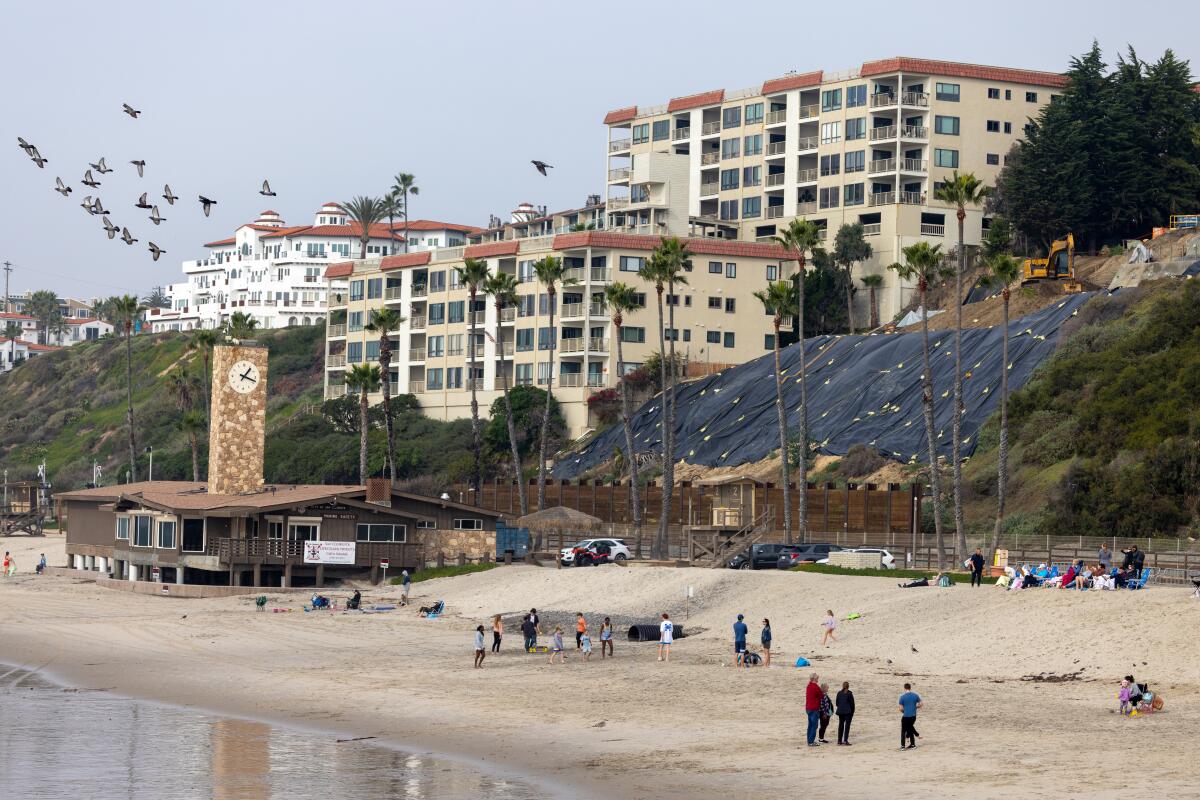
Though San Clemente’s beach nourishment project is smaller than its San Diego County counterparts, the city’s seashore is visibly bruised and has come to symbolize the costly conundrums of preparing for climate change along California’s coast.
On the north side of San Clemente’s pier, $8.5 million has gone to repairing the bluff at the Casa Romantica historical landmark, which crumbled in April and shut down the train tracks below it for months. A temporary barrier was erected last year as part of a $6-million effort to protect the railroad from becoming the weakest link in the Lossan corridor once again on account of another devastating landslide.
Two miles south of the pier, experts believe tidal erosion at the toe of another bluff helped activate a landslide in 2021. The following year, heavy rain and high surf shifted the ground beneath the train tracks at the landslide site, which prompted a $13.7-million effort to stabilize the area.
More recently, the Mariposa Bridge, which hovered over a critically eroded stretch of beach, closed indefinitely in late January after a landslide damaged the structure. Passenger train service remains suspended as Metrolink and the Orange County Transportation Authority began work on a $7.2-million wall last week to protect the railroad tracks.
While San Clemente waits for the resumption of its beach nourishment project, city officials are looking for other ways to find sand.
On Feb. 20, the San Clemente City Council directed staff to apply for a Sand Compatibility and Opportunistic Use Program (SCOUP) permit to transport sediment by truck or rail from possible sites like the Prado Dam or even landslide areas in the city.
“I would contrast this with the Army Corps project, which a planned project with a borrow site — the issues with the borrow site notwithstanding,” Leslea Meyerhoff, the city’s coastal administrator, told council members.
“It is another important tool to have in the toolbox,” she added.
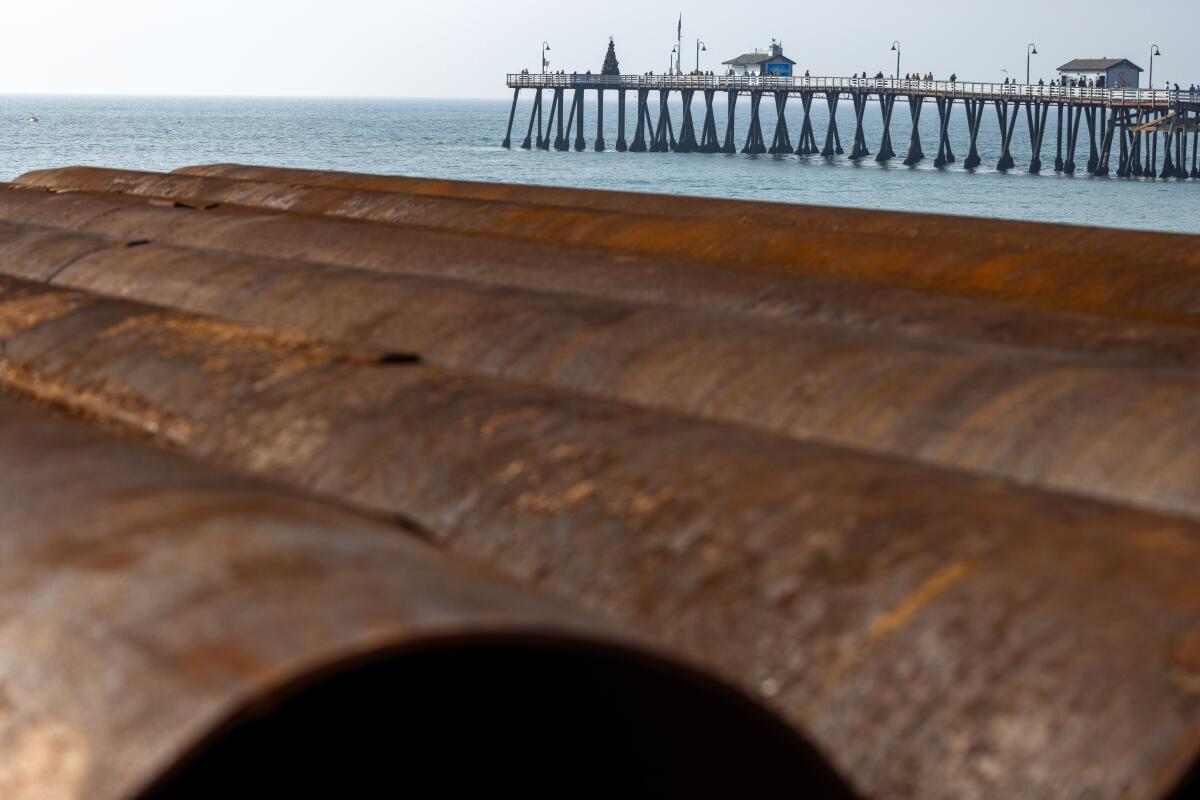
In the meantime, the Army Corps is exploring alternate borrow sites and hopes to speed up the permitting process to resume work in San Clemente as soon as possible.
The agency expects to complete the Solana Beach sand replenishment project by mid-March. After that, work will began in Encinitas, which is slated to take 45 days. Under that timeline, the earliest crews could return to San Clemente would be in May, which typically kicks off the summer season on Memorial Day weekend.
Whenever the Army Corps resumes work, heavy machinery and large pipelines will become familiar, reoccurring sights in San Clemente as sand replenishment is slated every six years through the life of the project.
For now, none of the initial sediment pumped onto the beach before the project’s delay will count towards the total cubic yards of sand promised by it.
San Clemente Councilman Chris Duncan called that determination an “important step” in hitting a reset button on the project, but as summer draws nearer, he doesn’t expect work to resume anytime soon.
“It’s a long shot to imagine that the project will be completed this year,” Duncan said, soberly. “But we’re not going to stop until we get all of the sand promised by it. We’re going to make it happen.”
All the latest on Orange County from Orange County.
Get our free TimesOC newsletter.
You may occasionally receive promotional content from the Daily Pilot.
